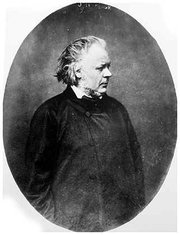|
|

Honoré Daumier (1808 – 1879) was a French caricaturist and painter.
Born in Marseille, Daumier showed in his youth an irresistible inclination towards the artistic profession, which his father vainly tried to check by placing him first with a huissier and subsequently with a bookseller. Having mastered the techniques of lithography, Daumier started his artistic career by producing plates for music publishers, and illustrations for advertisements; followed by anonymous work for publishers, in which he followed the style of Charlet and displayed considerable enthusiasm for the Napoleonic legend.
When, in the reign of Louis Philippe, Philipon launched the comic journal, La Caricature, Daumier joined its staff, which included such powerful artists as Devéria, Raffet and Grandville, and started upon his pictorial campaign of scathing satire upon the foibles of the bourgeoisie, the corruption of the law and the incompetence of a blundering government. His caricature of the king as Gargantua led to Daumier's imprisonment for six months at Ste Pelagic in 1832. Soon after, the publication of La Caricature was discontinued, but Philipon provided a new field for Daumier's activity when he founded the Le Charivari.
Honoré_Daumier_-_Gargantua.jpg
Daumier produced his social caricatures for Le Charivari, in which he holds bourgeois society up to ridicule in the figure of Robert Macaire, hero of a popular melodrama. In another series, L'histoire ancienne, he took aim at a pseudo-classicism which held the art of the period in fetters. In 1848 Daumier embarked again on his political campaign, still in the service of Le Charivari, which he left in 1860 and rejoined in 1864.
In spite of his prodigious activity in the field of caricature — the list of Daumier's lithographed plates compiled in 1904 numbers no fewer than 3,958 — he also painted. Except for the searching truthfulness of his vision and the powerful directness of his brushwork, it would be difficult to recognize the creator of Robert Macaire, of Les Bas bleus, Les Bohémiens de Paris, and the Masques, in the paintings of Christ and His Apostles (Rijksmuseum in Amsterdam), or in his Good Samaritan, Don Quixote and Sancho Panza, Christ Mocked, or even in the sketches in the Ionides Collection at South Kensington.
But as a painter, Daumier, one of the pioneers of naturalism, did not meet with success until a year before his death in 1878, when M. Durand Ruel collected his works for exhibition at his galleries and demonstrated the range of the talent of the man who has been called the "Michelangelo of caricature". At the time of the exhibition, Daumier was blind and living in a cottage at Valmondois, which Corot placed at his disposal. There he died in 1879.
An exhibition of his works was held at the École des Beaux-Arts in 1900.
External links
- Extensive information on Honoré Daumier and his life and works, bibliography, and exhibitions (http://www.daumier.org)
- www.daumier-register.org Daumier Register: Digital work catalogue of the complete lithographic oeuvre of Daumier, illustrated and with interactive search functions.
Template:Commonscatde:Honoré Daumier fr:Honoré Daumier he:אונורה דומיה nl:Honoré Daumier ja:オノレ・ドーミエ ru:Домье, Оноре sv:Honoré Daumier
